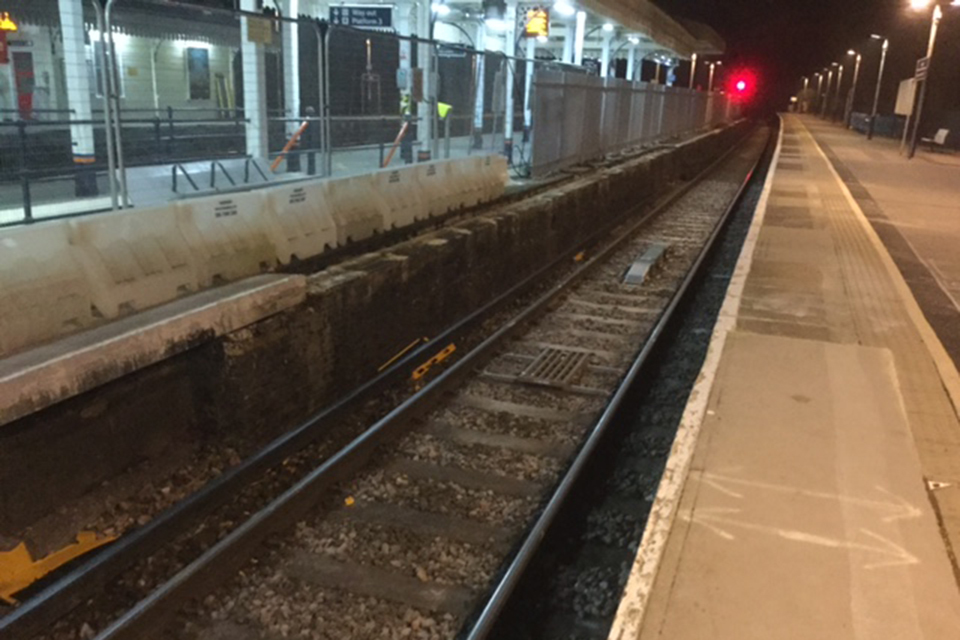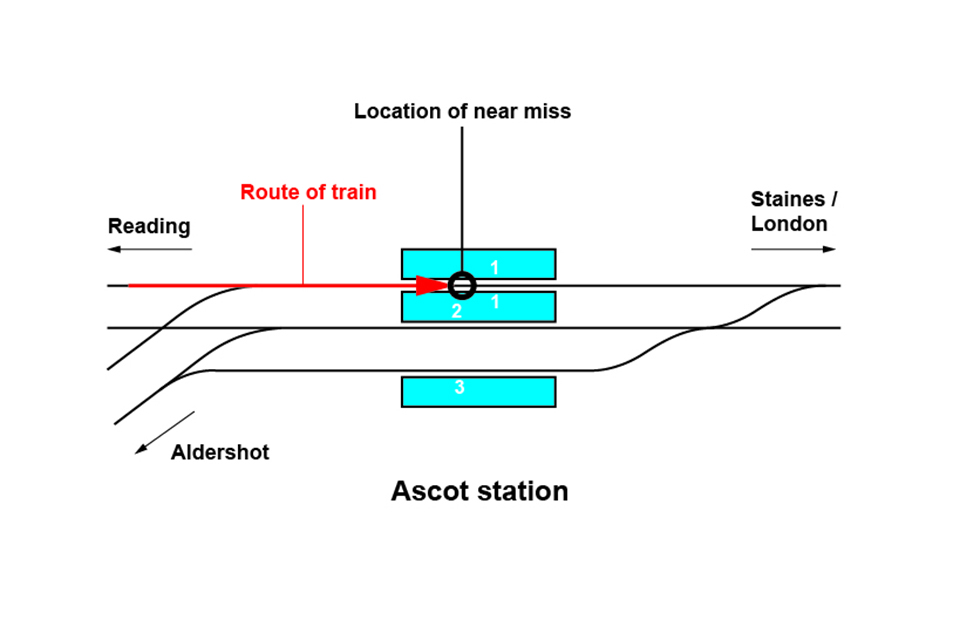Near miss at Ascot, Berkshire, 7 April 2017
Published 20 June 2017
1. Important safety messages
This incident:
- highlights the importance of good quality safety critical communications, and of both parties confirming a common understanding of the message being conveyed.
- demonstrates that it is preferable for controllers of site safety to receive a face-to-face briefing from the protection controller before signing the RT3181 form, and authorising the team to start work. Staff are reminded that the COSS must always sign the RT3181 to confirm that a line blockage is in place unless it has been previously planned otherwise.
2. Summary of the incident
At approximately 01:30 hrs on Friday 7 April 2017, two track workers narrowly avoided being struck by a train at Ascot station. They were working on a line that they mistakenly believed was blocked to trains. The track workers moved off the line less than three seconds before the arrival of the train. They were unhurt in the incident.

Platform 1 at Ascot station where the work was taking place showing the platform edge and the running line with the third rail(courtesy Network Rail)
The track workers were standing on the up line at platform 1 as the train approached; the 01:11 hrs Reading to Staines empty stock movement was travelling at close to the maximum permitted speed of 70 mph (113 km/h). The train approached after the controller of site safety (COSS) had fitted insulating shrouds over the conductor rail and climbed back onto the platform, and prior to the two track workers starting work on the adjacent platform edge; there is a platform face on each side of the track at this location. The driver of the train saw the track workers as he approached Ascot station. He immediately sounded the horn and applied the emergency brake. This reduced the speed of the train from 67 to 43 mph (108 to 69 km/h) in the 9 seconds it took to reach the workers. One of the track workers saw the headlight of the approaching train and they both climbed onto the platform 2 to 3 seconds before the train passed. The train came to a stop with its rear portion still in the platform. The driver reported to the signaller that a near miss had taken place.

Schematic diagram of track layout at Ascot station showing the path of the train and the location of the near miss
3. Cause of the incident
The track workers were intending to carry out work on the edge of platform 1 as part of the ‘Reading 10-car project’. This work was planned to take place during a line blockage that was due to start after the last train of the night, the one involved in the near miss, had passed. The line blockage was planned to provide protection to a number of work groups. A COSS was allocated to ensure the safety of the work group at each worksite. In accordance with the railway Rule Book, the line blockage was to be under the control of a Protection Controller (PC) who had to liaise with each COSS. The near miss happened because the COSS incorrectly believed that the PC had informed him that the line blockage was in place.
When taking a line blockage the PC fills in an RT3181 ‘Line Blockage Form’, in conjunction with the signaller. This details the sections of line to be blocked and how this will be implemented. The PC records details of each COSS that is to work within the line blockage and when the authority to work is given to them. He also records when each COSS reports back that the work is complete and line blockage protection is no longer needed. There is also space for each COSS to sign both the receipt and handing back of the line blockage. This signature is always required unless it has been previously planned that it will not be necessary.
This was the fifth night of the work at Ascot with the same line blockage arrangements. Each night the PC, who was located at Ascot station, had set up the line blockage with the signaller and then telephoned each COSS to advise that it was in place. He recorded this on the RT3181 form. Although the COSS for the platform work and a COSS for other station work were also both at Ascot station, the PC had telephoned them on the previous nights, along with all the more remote COSSs, when he had received the line blockage. He then filled in the form without getting any COSSs to sign it to acknowledge that the line blockage was in place.
Shortly before the incident on 7 April, the COSS for the platform work had gone to the site office to fill in some paperwork. While the COSS was there, the PC was talking on the telephone with the signaller regarding arrangements for the block. A recording of the telephone call between the PC and the signaller showed that the PC understood that the up line was still open to traffic. Following this, there was a conversation between the PC and COSS that included discussion of the protection arrangements and the expected time that the line blockage would end. Although the details of the conversation are not recorded, both the COSS and the PC recall confirming that the end time for the block was to be the same as previous nights. However, the COSS also believed that the PC had informed him that the line blockage was in place and that it was safe to start work. The COSS had not repeated this information back to the PC to confirm that this was the case, and had not signed the RT3181 form. The COSS then proceeded to the platform and briefed his work party that the line was blocked. The COSS went on to the track to install the conductor rail shrouds, with the up line still open to trains, before allowing the two track workers on to the track to start work.
The incident resulted from a breakdown in the communications between the COSS and the PC. The COSS did not confirm his understanding of the information that he believed that he had obtained from the PC. This led him to believe that the line was blocked when it was still open to trains. The railway Rule Book instructs that individuals must make sure that they properly understand the meaning of all messages whether they are communicated by phone, radio or face-to-face. It also requires that if someone is receiving a message they must repeat the message back so that the other person knows that it has been correctly understood; this applies to all forms of communication, including face-to-face. The routine practice of the PC in briefing COSSs of the line blockage by telephone, when a face-to-face briefing and confirmatory signature was practicable, was also a factor.
4. Previous similar occurrences
RAIB has previously investigated a number of accidents and incidents involving track workers. It has recently published a report for an investigation into the safety of track workers outside possessions RAIB report 07/2017. Accidents with similarities to the near miss at Ascot include:
- Heathrow Tunnel Junction, 27/28 December 2014 RAIB report 20/2015. A breakdown in communications and the safe system of work led to two incidents where groups of track workers accessed lines that were open to traffic while believing that trains had been stopped.
- Bridgeway UWC, 16 January 2014 RAIB report 25/2014. Miscommunication between personnel and a misunderstanding of the paperwork resulted in a welder’s trolley being placed on a line that was open to trains and subsequently being struck.
You can print this safety digest.

